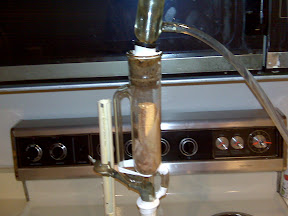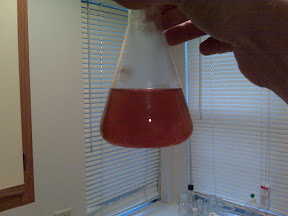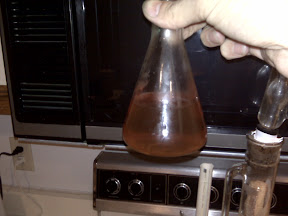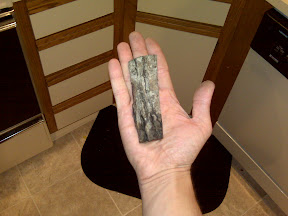| Pages:
1
2 |
tom_servo
Hazard to Self
 
Posts: 52
Registered: 11-11-2008
Member Is Offline
Mood: No Mood
|
|
soxhlet extracting oils?
ok so can some one tell me is this really working?
Added a filter and a piece of wood to a soxhlet extractor, put a condensor on top and put this all on top a rbf with water in it. boiled all night and
the water has all turned brownish color and smells like the wood.

did this work like steam distillation?


is this oil/water in the flask?

This is the wood it was derived from
please don't make fun of the equipment some of us are poor
[Edited on 13-11-2008 by tom_servo]
|
|
|
jokull
National Hazard
   
Posts: 506
Registered: 22-2-2006
Location: Everywhere
Member Is Offline
Mood: Ice glassed
|
|
Hi.
Quite wise to include pics!
Judging by the color I would say you mostly extracted tanines.
If you want to extract the essential oil by soxhlet it is better to use hexane.
Maybe you can find useful the two volume set of "The Chemistry of Essential Oils and Artificial Perfumes"
|
|
|
tom_servo
Hazard to Self
 
Posts: 52
Registered: 11-11-2008
Member Is Offline
Mood: No Mood
|
|
dont have access to hexane.
Perhaps one should just use a pressure cooker copper tube to bucket method?
|
|
|
watson.fawkes
International Hazard
    
Posts: 2793
Registered: 16-8-2008
Member Is Offline
Mood: No Mood
|
|
A soxhlet can extract low-solubility products, but it has a harder time extracting zero solubility one. An upper bound on the rate of extraction is
given by (1) the volume of fluid removed per siphon (2) the number of siphons per unit time and (3) the solubility of the material in the solvent. So
if your product is nearly insoluble, it will take a long time. This is the reason to recommend hexane, as the solubility is higher. It need not be
high, but the difference between 0.01% and 1.0% is a factor of up to 100 in extraction speed.
Another governor of extraction speed is surface area. More surface area means more solvent exchange per unit time, up to a point. That point is where
diffusion within the solvent becomes the limiting factor. With a block of wood, you're not up to that point yet.
|
|
|
tom_servo
Hazard to Self
 
Posts: 52
Registered: 11-11-2008
Member Is Offline
Mood: No Mood
|
|
ok 1) where can hexane be obtained OTC or distilled from.
2) would it be wiser to chop the wood into little pieces and try it?
3) would the pressure cooker method be better? and can it be just water or should hexane be used?
|
|
|
watson.fawkes
International Hazard
    
Posts: 2793
Registered: 16-8-2008
Member Is Offline
Mood: No Mood
|
|
| Quote: | Originally posted by tom_servo
3) would the pressure cooker method be better? |
I think you'd better explain what the "pressure cooker
method" is, because I have no way of knowing which of the many ways one might apply a pressure cooker to this problem that you're thinking of. I'm
guessing that others have the same issue.
|
|
|
tom_servo
Hazard to Self
 
Posts: 52
Registered: 11-11-2008
Member Is Offline
Mood: No Mood
|
|
here is what i was told before
Find a few 5 gal. plastic buckets, try to find one w/h a lid on it. Buy a yardsale quality pressure cooker, and 2 hotplates. Buy ~ 10' of ~ 1/2'' ID
copper tube from your hardware store. Get some good waterproof glue, and about ~ 15' of ~ 1/2'' high temp. plastic hose.
Amend your pressure cooker. You want one outlet in the lid. Plug any others. It now won't build up pressure and explode, if you walk off your porch
and forget it too long. Fill pressure cooker 3/4 way w/h distilled water. Put an upside down colander in bottom of 5 gal. pot w/h lid. Heat up your
copper pipe, melt a quick, tight, hole in lid. Cut flexible plastic pipe in half. Put your flex pipe in bottom of pot, under the colander, and up
through the pots lid. Glue/silicone in place. Silicone other end of flex pipe to top of p. cooker. Better put a fitting. Melt 2ed hole in lid of 5
gal. bucket as per 1st. Silicone securely. It only needs to go a few inches into lid.
When its all dry, fill up p. bucket w/h roots. Put lid on bucket, and wrap some insullation around it if you have any. In 2ed bucket, melt a 1/2''
hole near the bottom. Find something round, but smaller than bucket. A fire ex. worked. Wrap the copper around it. Now put copper spiral in 2ed
bucket, silicone at bottom, have ~ 6'' sticking out. At top./other end of bucket. connect copper and plastic tubing. Fill 2ed bucket w/h ice. Finish
later.
Now put high heat under p. cooker, heat p. bucket on low using sand bath. (an old wock fill w/h sand) Steam comes out of p. cooker and into 1st
bucket, lifting oils out of wood. Steam and oil condense in cool coils of 2ed bucket, drip into whatever jug you put there. This type oil is heavier
than water, so it sinks to bottom. Pour off water, seperate last w/h sep. funnel. Just like its been done 100's of years.
|
|
|
watson.fawkes
International Hazard
    
Posts: 2793
Registered: 16-8-2008
Member Is Offline
Mood: No Mood
|
|
| Quote: | Originally posted by tom_servo
Find a few 5 gal. plastic buckets [... etc.] |
What you've described is a steam distillation rig. Its
extraction is to volatilize by heat transfer. Steam condenses, releasing latent heat, which heats the target substance, vaporizing it. Collect and
condense vapors. Like soxhlet extraction, this technique favors free surface area.
You asked if this method would be better than soxhlet extraction. I don't know, since you haven't stating what, exactly, you're trying to accomplish.
|
|
|
tom_servo
Hazard to Self
 
Posts: 52
Registered: 11-11-2008
Member Is Offline
Mood: No Mood
|
|
extracting oil out of wood like in the pictures provided
Would it be better to cut the wood into smaller chunks?
this is to obtain essential oils
|
|
|
watson.fawkes
International Hazard
    
Posts: 2793
Registered: 16-8-2008
Member Is Offline
Mood: No Mood
|
|
| Quote: | Originally posted by tom_servo
extracting oil out of wood like in the pictures provided[...] this is to obtain essential oils |
Wood? Or
roots? The texture might matter.
|
|
|
tom_servo
Hazard to Self
 
Posts: 52
Registered: 11-11-2008
Member Is Offline
Mood: No Mood
|
|
root bark
|
|
|
watson.fawkes
International Hazard
    
Posts: 2793
Registered: 16-8-2008
Member Is Offline
Mood: No Mood
|
|
| Quote: | Originally posted by tom_servo
root bark |
I'm wondering if you'll also need a fractional distillation step after the steam distillation.
Will you need to separate the safrole from the other components in the sassafras oil?
|
|
|
not_important
International Hazard
    
Posts: 3873
Registered: 21-7-2006
Member Is Offline
Mood: No Mood
|
|
Smaller pieces are better, more of the plant material exposed; this is especially true for steam distillation as the organics have to escape from the
solids and be exposed on the water surface (including interior of bubbles. A course sawdust would be better than bulk chunks or even lentil size bits.
Consider investing in a second hand kitchen blender.
For organic extraction you could use acetone, "100%" isopropanol (solvent grade), xylene, or make your own petroleum ether by fractionating motor
fuel. Taking ordinary petrol and distilling it using a water bath with give you the C5 through C7 alkanes, plus ethanol or MTBE if either is in the
fuel. For your application those don't matter, they will work as solvent too.
|
|
|
tom_servo
Hazard to Self
 
Posts: 52
Registered: 11-11-2008
Member Is Offline
Mood: No Mood
|
|
| Quote: | Originally posted by watson.fawkes
| Quote: | Originally posted by tom_servo
root bark |
Will you need to separate the safrole from the other components in the sassafras oil?
|
Never said it was sassafras I believe the legality of that is questionable
|
|
|
tom_servo
Hazard to Self
 
Posts: 52
Registered: 11-11-2008
Member Is Offline
Mood: No Mood
|
|
| Quote: |
For organic extraction you could use acetone, "100%" isopropanol (solvent grade), xylene, or make your own petroleum ether by fractionating motor
fuel. Taking ordinary petrol and distilling it using a water bath with give you the C5 through C7 alkanes, plus ethanol or MTBE if either is in the
fuel. For your application those don't matter, they will work as solvent too. |
Using fuel seems like it would be kind of a hassle since I'm not sure what one would be looking for during the distilling of it
But Acetone is easy to come by and not too expensive
perhaps chopping up roots to little pieces throwing in a blender then distilling with acetone will be the best bet, but wouldnt that make it more of a
hassle using a pressure cooker??
|
|
|
not_important
International Hazard
    
Posts: 3873
Registered: 21-7-2006
Member Is Offline
Mood: No Mood
|
|
Distilling with acetone will do little to nothing, it would be used for extraction which is not distillation. You distill the solvent in a Soxhlet
style extractor, but the substances extracted stay in the boiling flask; it's the condensed solvent running over the material to be extracted that
does the work, bring stuff into solution and carrying that to the boiling flask.
Steam distillation is a form of codistillation, and depends on the effect of heating two or more (nearly) immiscible liquids, when the sum of their
vapour pressures equals atmospheric pressure they codistill in proportion to their individual vapour pressures.
The pressure cooking is just a way to kludge together a large still pot with a wide mouth. Milk cans can work as well, just about anything you can
get a decent seal on that will take temperatures a bit above 100 C does the trick. Check the various home brew/distilling sites.
For whatever you use for a large steam still, run at least one distillation with just water, to remove volatiles from and of the materials you used in
construction.
|
|
|
JohnWW
International Hazard
    
Posts: 2849
Registered: 27-7-2004
Location: New Zealand
Member Is Offline
Mood: No Mood
|
|
What species of tree was that piece of wood from? Some species, like cinnamon, sassafras, sandalwood, cedar, eucalyptus, melaleuca, leptospermum, and
camphor, have valuable essential oils in their timber, bark, leaves, or roots.
|
|
|
Nicodem
Super Moderator
      
Posts: 4230
Registered: 28-12-2004
Member Is Offline
Mood: No Mood
|
|
Tom_servo, please post threads with improperly described problems and vague questions to the Beginnings section where I'm moving it anyway. Expecting
our members to do guess work about what your problem is, what you are extracting and exactly you want is irresponsible. How do you expect anybody can
answer to your problem if you don't explain what are you doing? Asking what method of extraction would be most appropriate when you don't even explain
what compound or mixture of compounds you want to extract and from where is like asking what transportation mean would be most appropriate without
telling where you are headed and where from (in short: it is totally dumb).
|
|
|
Phosphor-ing
Hazard to Others
  
Posts: 248
Registered: 31-5-2006
Location: Deep South, USA
Member Is Offline
Mood: Inquisitive
|
|
| Quote: | Originally posted by tom_servo
ok 1) where can hexane be obtained OTC or distilled from.
|
Hexane is found in electrical contact cleaners, usually with CO2 as the propellant. Just read the labels and you should have no trouble finding a
suitable brand to extract hexane from.
"The nine most terrifying words in the English language are: 'I'm from the government and I'm here to help.'" -Ronald Reagan
|
|
|
watson.fawkes
International Hazard
    
Posts: 2793
Registered: 16-8-2008
Member Is Offline
Mood: No Mood
|
|
| Quote: | Originally posted by tom_servo
Never said it was sassafras I believe the legality of that is questionable |
You said everything but that.
- You have a new account, with which you ask a number of complete newbie question in multiple threads.
- You've been acting cagey, providing minimal information about what you're trying to do, and only saying it after direct questioning.
- You describe a medium-sized batch recipe as if this is an appropriate scale to try out out a process you've never done.
- You're impatient, worried about "hassle", looking for short cuts. This indicates you don't care much about understanding as such, and would
rather just have a recipe.
- You assume that people know your lingo ("pressure cooker method") and persist using it (instead of "steam distillation") even after it's
explained to you what the ordinary usage is.
- You don't know what it means to increase surface area, and don't ask what that means, presumably because that's about understanding, not about
the recipe.
- First you say wood, the post a recipe mentioning roots, and finally admit that it was root bark, which means you're hiding something.
All this screams "drug cook". Even if you're not, this forum is much, much more about understanding than recipes. If all you want is a recipe,
you may well have better fortune elsewhere.
If you would like me to believe you that you're not a drug cook, I suggest immediately becoming extraordinarily forthright. What are you extracting
from, exactly? What's the material in the photo? What are you trying extract from it, exactly? And what are you going to do with it once you have it?
|
|
|
tom_servo
Hazard to Self
 
Posts: 52
Registered: 11-11-2008
Member Is Offline
Mood: No Mood
|
|
ok wow so now it is time to defend myself
1 yes I have a new account, ive been "lurking" for some time now I don't usually ask things just try what others discuss doing because I don't want to
be put in to situations where I have to defend myself
2 I apologize i didn't realize that the physical traits of bark differ that much between roots and the rest of a tree
3 It is wood I didnt feel that "wasting it" in a medium size batch would be a that much of a problem
4 I don't see how you got this idea, I know plenty of "recipe's" I am trying to understand it this is unfounded
5 I used the term pressure cooker method because I was referring to using a pressure cooker, I have seen many other ways to use steam distillation
sans pressure cooker. I also explained the general idea of what I mean
| Quote: |
Perhaps one should just use a pressure cooker copper tube to bucket method?
|
6 I knew what that meant, I just didnt know if you meant with the wood or in the condenser like a viguerex column
7 once again i didnt realize there was that big of a difference, so what your saying is when i want to obtain some pine oil, or another fragrance oil
it will have to be a totally different procedure?
You can think im the unibomber for all I care.
I dont see any points where you explain what you need sulfuric acid for
| Quote: |
I've been looking into what it would take to build a miniature-scale contact process reactor for making sulfuric acid.
|
or why the hell you would want V2O5 catalyst
Look I thank your for giving advice like i stated in one of my posts maybe not this one, I'm kind of new to this. Chemistry interests me a great deal.
I almost screamed when i turned copper wire into green crystals i was so exited (although not what i was trying to do).
If you don't want to give me advice thats fine
IF no one else does then just have the admins kick me off the board.
|
|
|
tom_servo
Hazard to Self
 
Posts: 52
Registered: 11-11-2008
Member Is Offline
Mood: No Mood
|
|
| Quote: | Originally posted by Phosphor-ing
| Quote: | Originally posted by tom_servo
ok 1) where can hexane be obtained OTC or distilled from.
|
Hexane is found in electrical contact cleaners, usually with CO2 as the propellant. Just read the labels and you should have no trouble finding a
suitable brand to extract hexane from. |
Thank you
|
|
|
tom_servo
Hazard to Self
 
Posts: 52
Registered: 11-11-2008
Member Is Offline
Mood: No Mood
|
|
Oh and yes it is root bark from a sassafras tree
Sassafras oil is the desired product
|
|
|
watson.fawkes
International Hazard
    
Posts: 2793
Registered: 16-8-2008
Member Is Offline
Mood: No Mood
|
|
I've been challenged, and I'll briefly defend myself. Although the topic's not exactly relevant here, I'm interested it sulfuric acid production in
order to change the facts on the ground relevant to the political control of chemical manufacture. (That's the bulk of my interest here generally.)
For further discussion, please take the political aspects to new threads in the proper section, and the technical aspects to the thread where they
were first raised.
I asked the question about roots and wood in order to detect deceit. There's no particular difference for steam distillation, in actuality. But you
first said wood, and then said roots, and then said root bark, and have finally said sassafras root bark. You know, I'm neither a trained investigator
nor interrogator. The people who do that for a living are much better than me at ferreting out deceit.
So, some personal advice. It's something of a maxim that only (or mostly only) stupid criminals get caught. If you are considering criminal activity
(such as unreported manufacture and sale of safrole), stop now. You'd get caught. I'm not saying anything about any lack of ultimate intelligence
(indeed, excitement over metal salts crystals speaks otherwise), but insofar as you might be considering chemically-oriented crime, just stop now.
You're situationally stupid about it.
Now, let me assume that you actually want to understand steam distillation. First, slow down. This is not the kind of activity where you start big.
Second, forget the large batch reactor. Start with something smaller that you can fit entirely on your kitchen counter. A pressure cooker still makes
a good steam source, but you only need a small one. Use a tin can of about a pound capacity to hold your raw material instead of a 5 gallon bucket.
You'll also need a smaller condenser coil.
Third, ditch the idea of starting with sassafras bark. In today's political climate, it's just the wrong first material. I suggest spearmint. It's
plenty cheap, it grows like a weed (and is a weed for some), and it has plenty of menthol. If you have any interest in mint juleps or mojitos, use the
oil and the aquasol to make some beverages.
Fourth, read up. Start with The Chemistry of Essential Oils and Artificial Perfumes, which was already recommended to you. It's easy to find
online. I can also recommend The Compleat Distiller, which has a chapter on steam distillation. It's a relatively short chapter, but
perfectly good. Indeed, the combination of scientific and practical exposition put it into an unfortunately-not-common-enough category.
[Edited on 14-11-2008 by watson.fawkes]
|
|
|
tom_servo
Hazard to Self
 
Posts: 52
Registered: 11-11-2008
Member Is Offline
Mood: No Mood
|
|
ok well one thing i have to say first, don't consider me unintelligent because I am amazed at the copper experiment
I may be uneducated on the ways of chemical reactions but I have a degree in computer science and hold many certification relative to computer
networking. I am highly intelligent and want to explore the path i decided to walk away from when i chose networking as a profession for reason
irrelevant to the topic at hand.
Second sassafras was chosen because it was readily available since the tree was just cut down and the rest of it is being used for firewood.
I would have no problem reading books on the subject, I admittedly have only read posts and articles on the internet about distillation. I only had a
couple questions regarding it, and to be honest understanding some of it is a little more difficult for me since I did not go to school for chemistry
and my experience tops out about sophmore year of highschool which was a long long time ago.
And about illegal drug manufacturing, the second sticky in the organic chemistry section is abotu a route from toulene to benzaldehyde a precurser to
methamphetamine if memory serves.
Intentions on my behalf are in no way related to making drugs for distribution. Just obtaining an oil that i enjoy the scent of which is at my
fingertips.
Oh and btw I despise menthol
|
|
|
| Pages:
1
2 |